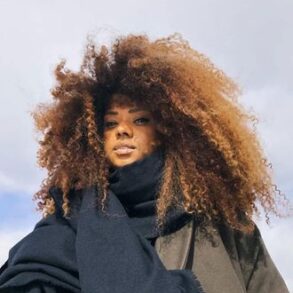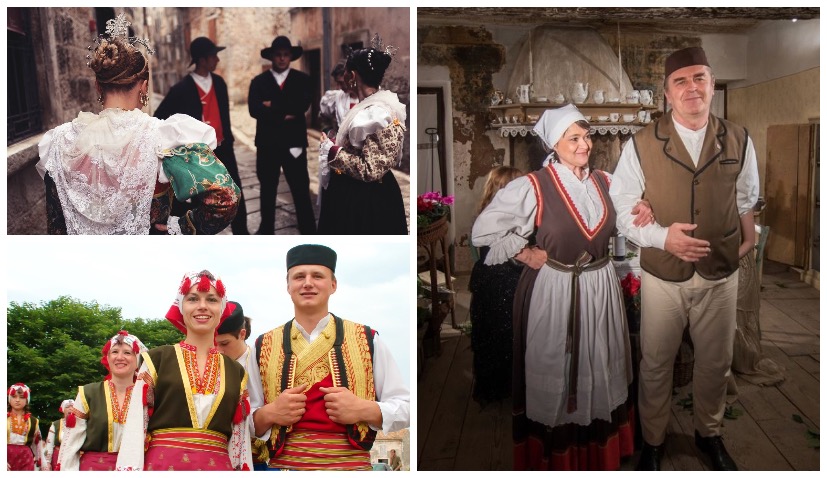
(Photos: Ana Lorencin/Danilo Dragosavac)
Olive groves and top-quality olive oil, historical places with beautiful beaches, dry stone huts called kažuni, numerous churches and religious treasures – these are just some the reasons to visit the Vodnjan area on Croatia’s Istrian peninsula. There is also something else as well to impress you about this part of Croatia – its carefully preserved folklore customs.
Vodnjan, Galižana and Peroj, as well as other places in the Vodnjan area, still cherish the gentle and archaic world of the bygone times woven of clear and picturesque reflections of the past.
The history of diligent and cheerful life imbued with spirituality is reflected in the preserved customs, every day and festive objects, books, music, dance and, most of all, traditional costume that keeps impressing with their beauty, colours and layers.
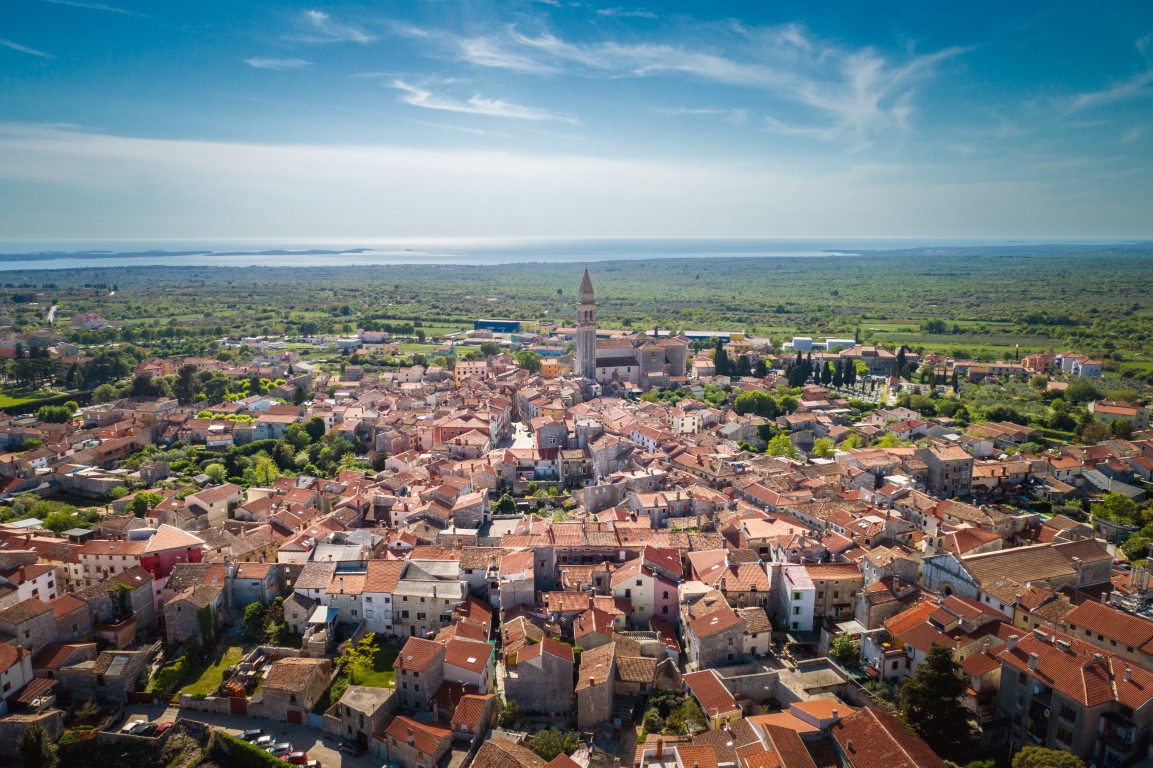
Vodnjan (Photo: Vodnjan photography)
A visit to the Vodnjan area, particularly during the holiday season, is an opportunity for each of its places to show off the precious heritage of its ancestors. LERON, an international folklore festival that brings local and international folklore groups to the streets of Vodnjan is definitely a great opportunity to get to know the folklore of the Vodnjan area.
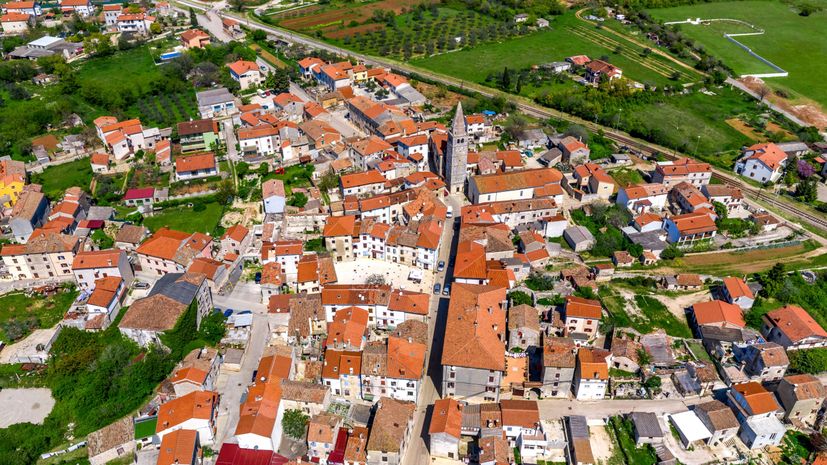
Galižana (Photo: TZ Vodnjan)
However, should you wish to discover a part of this identity right away, we will take you for a stroll through Vodnjan, Galižana and Peroj and introduce you to their former inhabitants in their festive clothes that occupy a special place in the heritage treasure trove of the Vodnjan area.
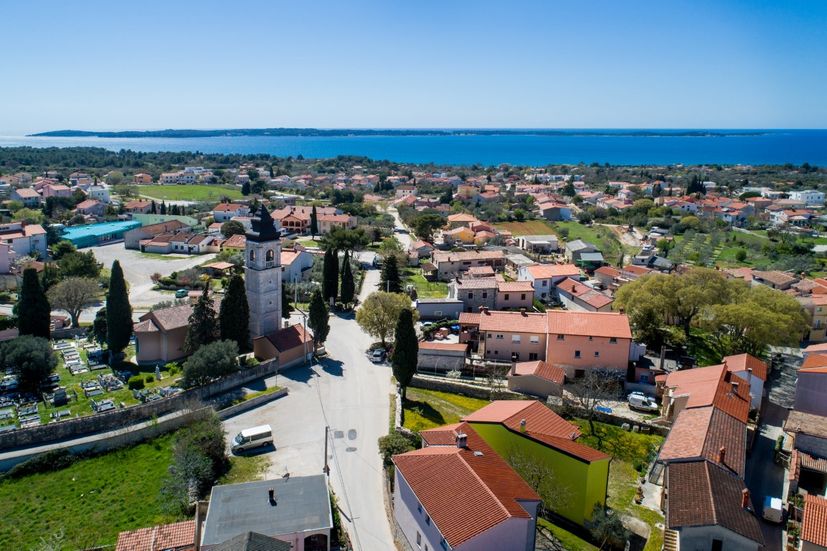
Peroj (Photo credit: Loris Zupanc photography)
VODNJAN’S COSTUME – Layering With Silver Lace Trimming
Over 4000 years have passed since the founding of Vodnjan, a town built on wisdom and unity of its inhabitants. The original inhabitants of Vodnjan called bumbari were blessed with an independent and original spirit; they were hardworking and religious, and they profoundly respected nature and its changes. Over the centuries, Vodnjan has been living as a homogeneous, rich rural place with numerous artisan workshops.
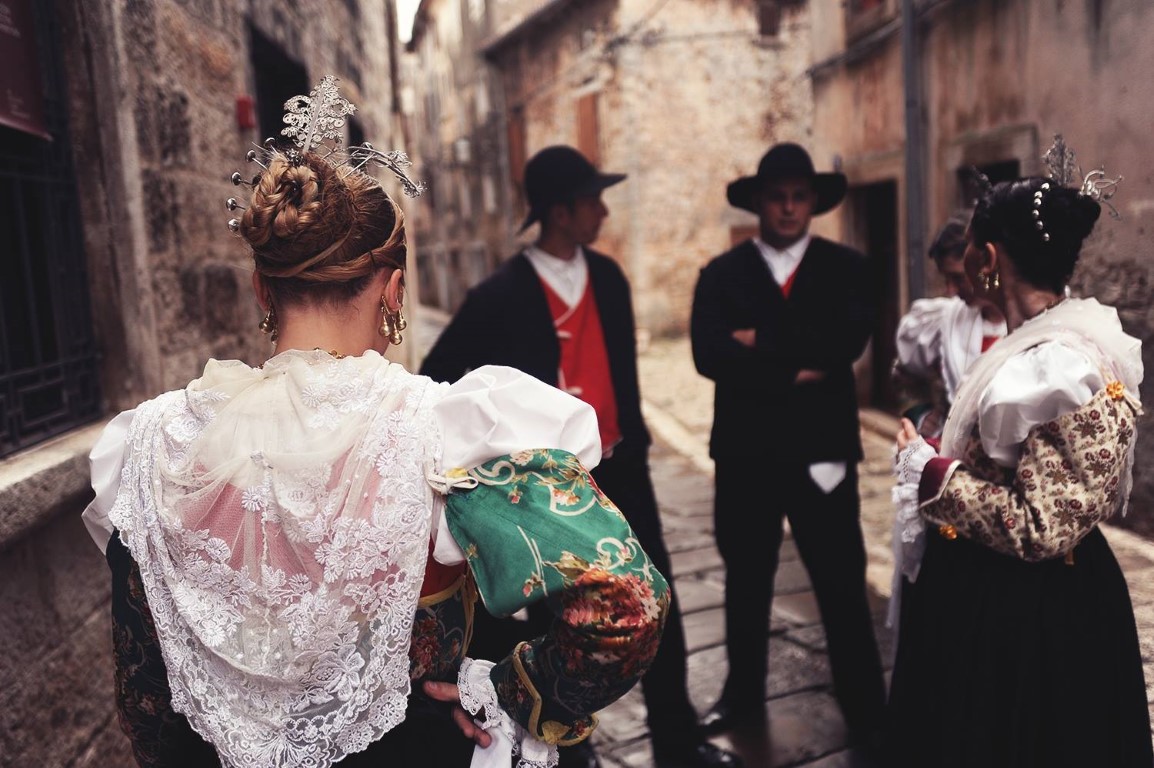
Vodnjan costume (Photo credit: Ana Lorencin)
Owing to a possibility of trading various goods, it was self-sufficient and independent. All inhabitants of Vodnjan knew each other, their family foundations were firm, they communicated in the specific Vodnjan’s dialect (favelà), later replaced by the Istrovenetian. They took pride in numerous customs and danced their characteristic dances called vilotta and forlana. Vodnjan’s folklore was based on autochthonous songs such as i bassi inscribed on UNESCO’s intangible cultural heritage list.
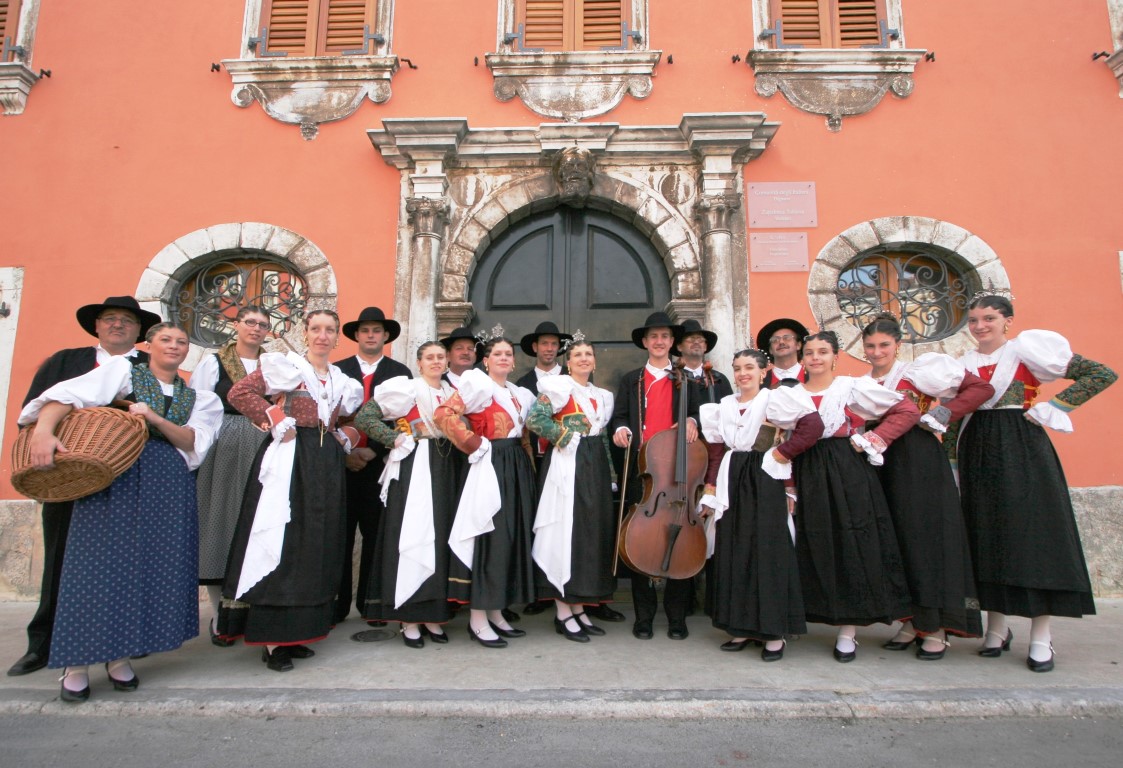
Vodnjan folk community (Photo credit: Danilo Dragosavac)
The main instruments were the violin and the leron, an indigenous instrument resembling the violin after which the above international folklore festival was named, and its players were mainly self-taught. The rich heritage and customs of Vodnjan are carefully preserved through a number of activities of the Italian Community Vodnjan.
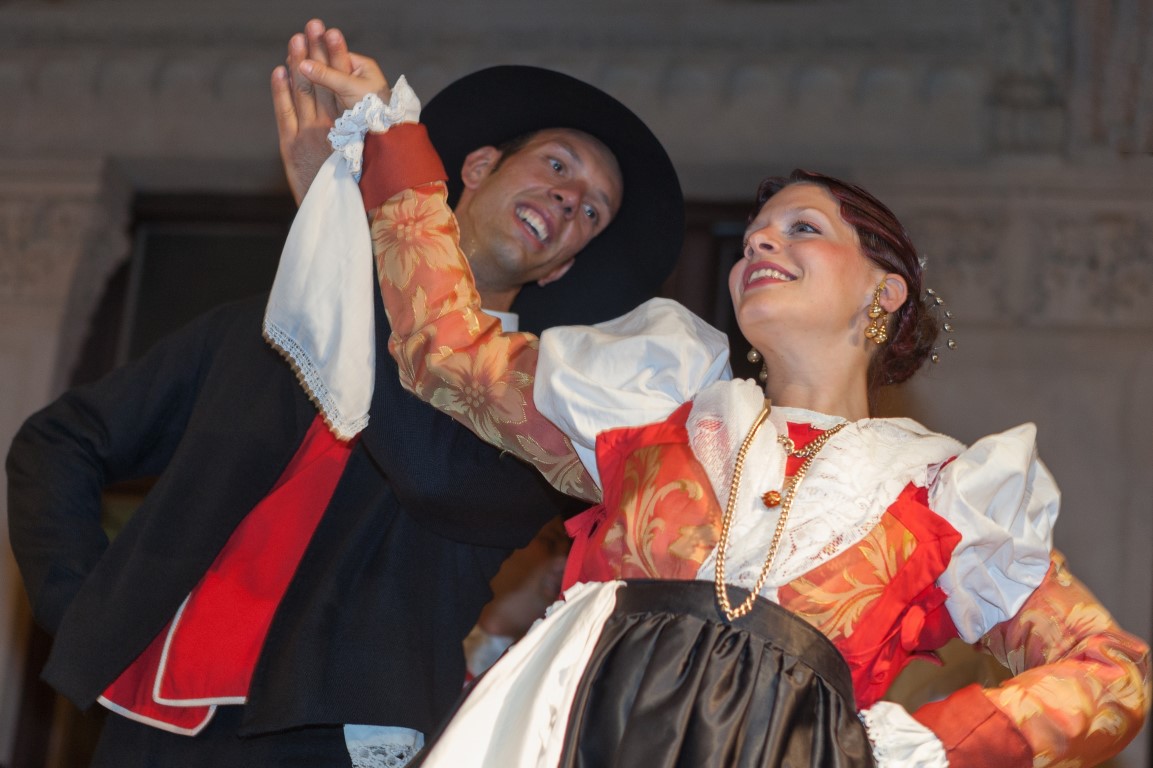
Vodnjan costime (Photo credit: Danilo Dragosavac)
Vodnjan’s Women’s Costume
Vodnjan’s costume is one of the versions of a wider Venetian area with the closest resemblance in the nearby Friuli. Rich and very layered, with striking colourful sleeves, it has always been admired and passed down in compliance with dowry contracts drawn up by notaries mentioning fabrics and decorative ribbons from Venice, lace and expensive scarfs.
Festive women’s costume consisted of braghise (white linen or hemp underpants decorated with lace), cameisa (shirt with lace around the neck and on the wrists with wavy and very wide sleeves), camisulein or bustein (vest made of cloth or bright red linen with wide straps), carpita (petticoat made of white, green or red cloth decorated with pleats, lace and embroideries), brasarola (colourful and decorated satin or brocade vest), soca (heavy black pleated skirt decorated with silver lace and red thread), manighe (colourful and decorated satin or brocade sleeves tied to the back of the red vest), traversa (apron made of silk or dappled damask), sintoura (colourful belt made of linen or leather decorated with silver buckles, velo (delicate white tulle scarf with ends crossed on the chest), tovajol (white headscarf), fasulito de fianco (large white embroidered linen scarf whose edge is attached above the apron), fasulito de man (embroidered or lace handkerchief held on the palm with an end attached to the rings), calse (socks made of white thread or wool) and scarpite (black shoes made of smooth leather).
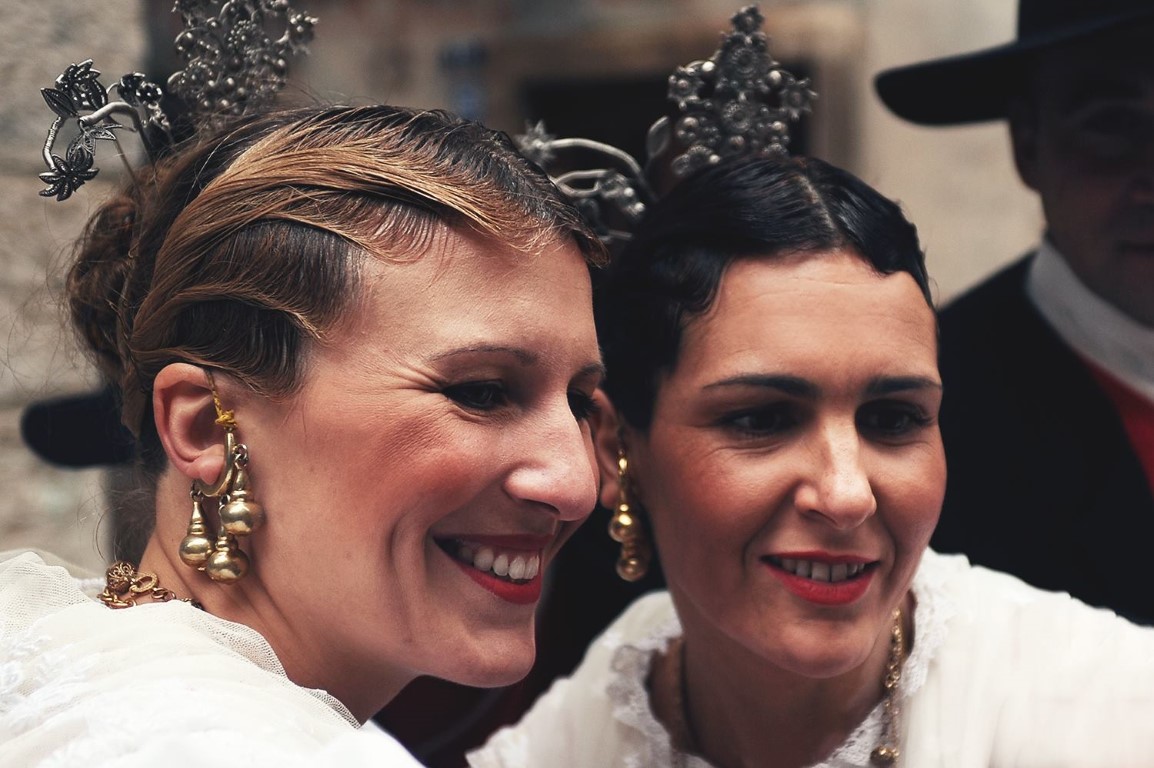
Vodnjan women (Photo credit: Ana Lorencin)
Women from Vodnjan wore rich jewellery: long, thick gold chains or pearls (cordon venezian) and gold earrings with three pendants (piroli), rings and brooches embellished with lapis lazuli and coral. To make their bachelor daughters as desirable as possible, the father had to secure as many as possible gold objects. Yet, the most fascinating is the very elaborate hairstyle with long, braided hair, locks and partings gathered into a bun (cogon), starting with waves (cape), which was decorated with rich jewellery consisting of numerous hair pins – pianeta, pianetola, trèmoli, ciodi, curarice (bigger and smaller filigree silver swords with floral decorations and flat head pins) radially arranged on the back of the head so as to resemble a halo. Interestingly, girls wearing the traditional costume were called marusse after the protagonist of Antonio Smareglia’s opera Nozze Istriane inspired by Vodnjan’s folklore.
Vodnjan’s Men’s Costume
Unsurprisingly, festive men’s dress (black, red and white) was simpler, although nonetheless impressive, and it consisted of the following parts: cameisa (shirt made of flax or white linen with very wide sleeves), camisulein (red vest decorated with thin double bound ribbons), braghe (black wool felt trousers), curito (black wool jacket with neck folds), fasuletein (white embroidered handkerchief) and bureicio (a type of long cloak or coat), whereas in the past, people from Vodnjan also used to wear natural leather shoes and gaiters called buseighini.
GALIŽANA’S COSTUME – Treasure Found in Dowry Contracts
Galižana, one of the oldest towns in Istria with characteristic rural Istrian stone architecture, has been inhabited since prehistoric times. Taking pride in its numerous churches, it meant a lot for the people from Galižana to be able to freely live and work as farmers and herdsmen thanks to the absence of infectious diseases that ravaged the region during the sixteenth and the seventeenth centuries.
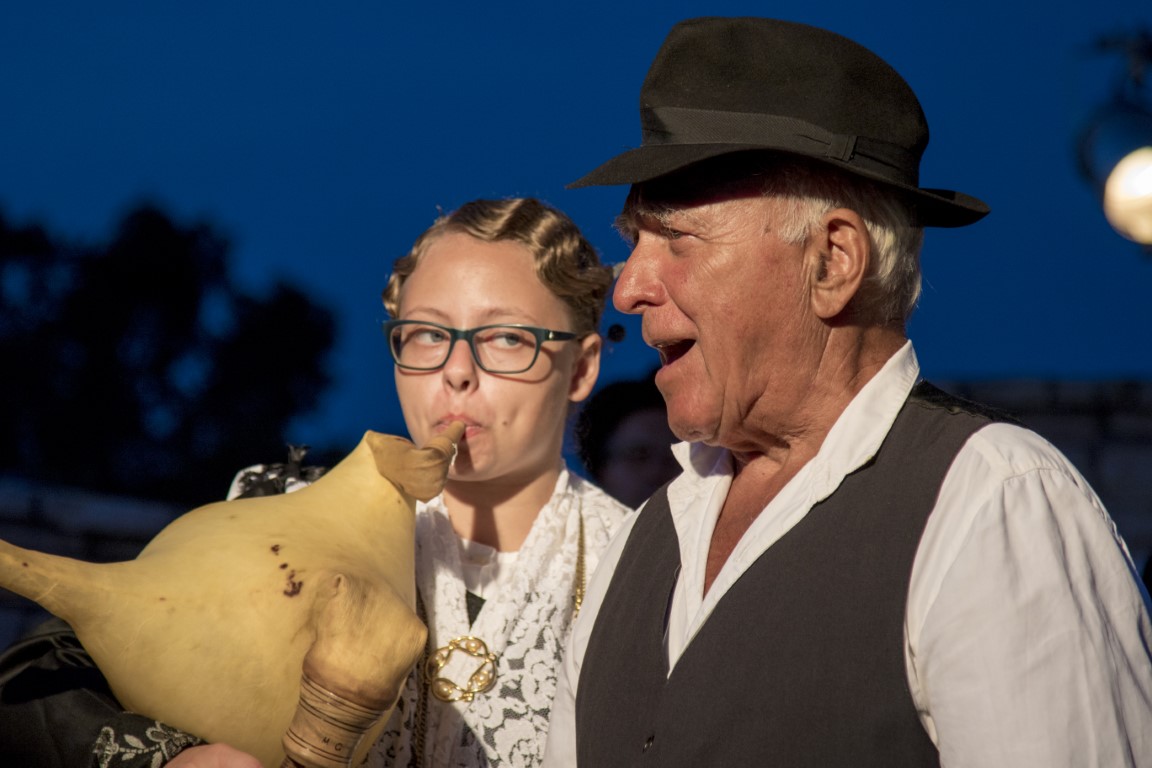
Galižana music heritage (Photo credit: Valter Zanco photography)
Today’s population of Galižana is around 1500. The majority of its inhabitants are members of the Italian Community that nurtures the language, songs, dances, music and special costumes – their deeply rooted characteristics.
People from Galižana are particularly proud of their rich vocal-instrumental tradition – the two-voice narrow-interval singing, i.e., singing divided into three groups (a la pera, a la longa and sota le pive). Galižana’s characteristic instruments are the pive (similar to the pipe organs from Abruzzo) and el simbolo (similar to the percussions), a North Adriatic combination that exists in Galižana and nowhere else. Galižana’s festive dress was a genuine treasure passed down from generation to generation, as documented in dowry contracts.
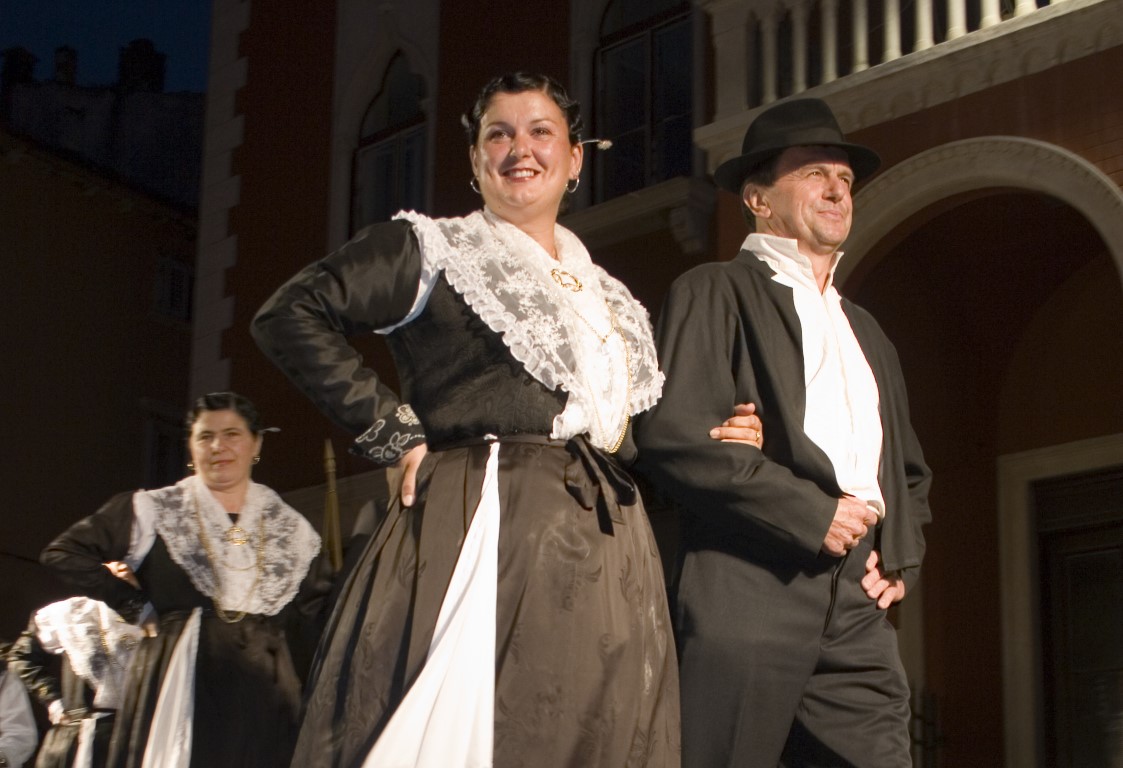
Galižana folk costume (Photo credit: TZ Vodnjan)
The most frequently passed down object was the wedding dress, later used as a festive dress.
Galižana’s Women’s Costume
The Galižana bride (la novisa) wore a shirt made of thin white linen (camisa) folded and decorated with lace around the neck, with sleeves pleated at the wrists and also decorated with lace from the wrist down. She wore a petticoat made of white linen embroidered on the edges (cotolo bianco de cotolina), with a black wool felt skirt (sochena or cotolo negro de gorgan) wide and ankle length, worn over the petticoat. Above the shirt, she wore a sleeveless vest made of black silk or brocade (camisolin). Detached sleeves made of black damask or brocade (manighe) were pulled over the shirt, and they had silk bottom sleeve edges decorated with embossed floral motifs.
Women from Galižana used to attach a silk or damask corset (brasarola) to the vest to look more elegant. Above the skirt, they wore a long apron or traversa tied in front into a bow. There was also a white handkerchief or fasoleto de nas or mus attached to the apron belt on one end. Around the neck, they wore an embroidered scarf (fasoleto de spale) with ends crossed on the chest and fastened with a gold brooch. There were also white cotton socks, hand knitted and knee high, and black shoes with or without laces.
Women from Galižana wore long gold necklaces wrapped around the neck multiple times consisting of small round filigree items (cordon a pirusini) or else one or several simple necklaces (cordon liso) with a pendant cross, heart or star. In their ears, they wore big gold earrings with three pear-shape pendants (piroli).
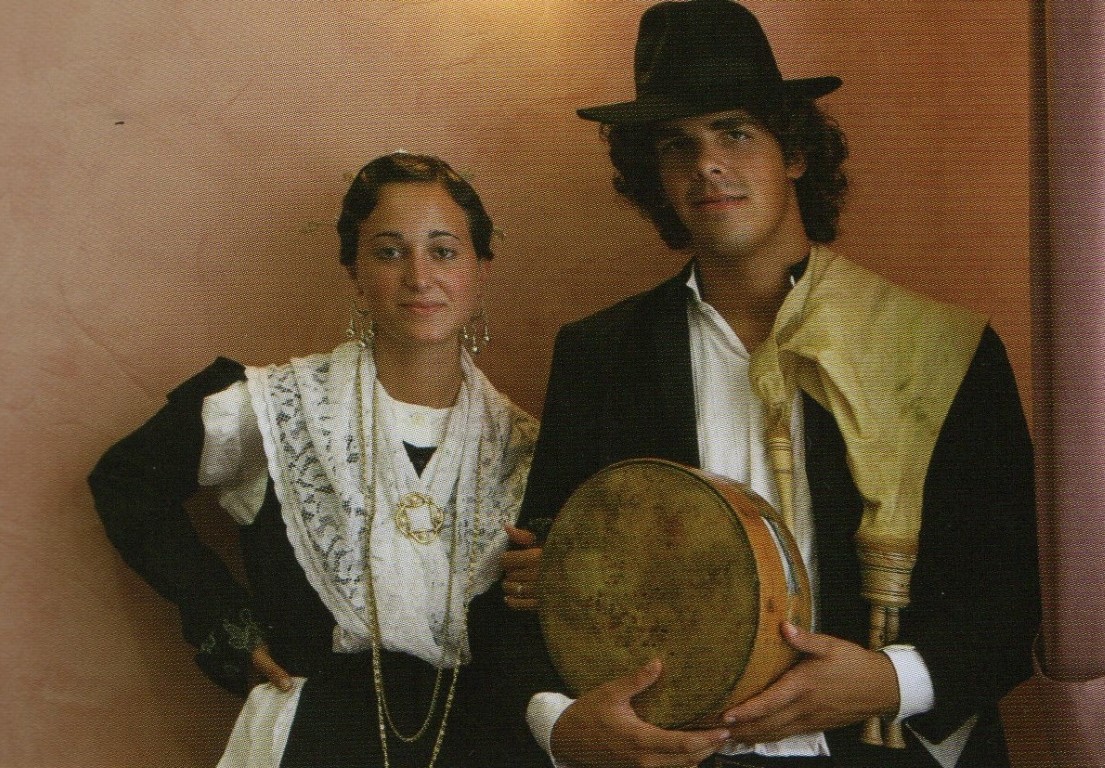
Galižana (Photo credit: Danilo Dragosavac)
On festive days, their hairstyles were in no way inferior to those worn by women from Vodnjan. Braids were gathered on the back of the head into a bun (cogon), and the locks on the front side were combed in waves (cape). The wavy parts of the hair were fixed with sugary water or laundry soap. The bun was decorated with hairpins. La spada (hilt sword shaped silver pin) had the central position, whereas le cioche (pins with filigree decorations) were unsymmetrically inserted on both sides, i trèmoli (pins with a spiral part and the flower-shaped head swinging as the wearer moved), and i ciodi (silver flat-head pins).
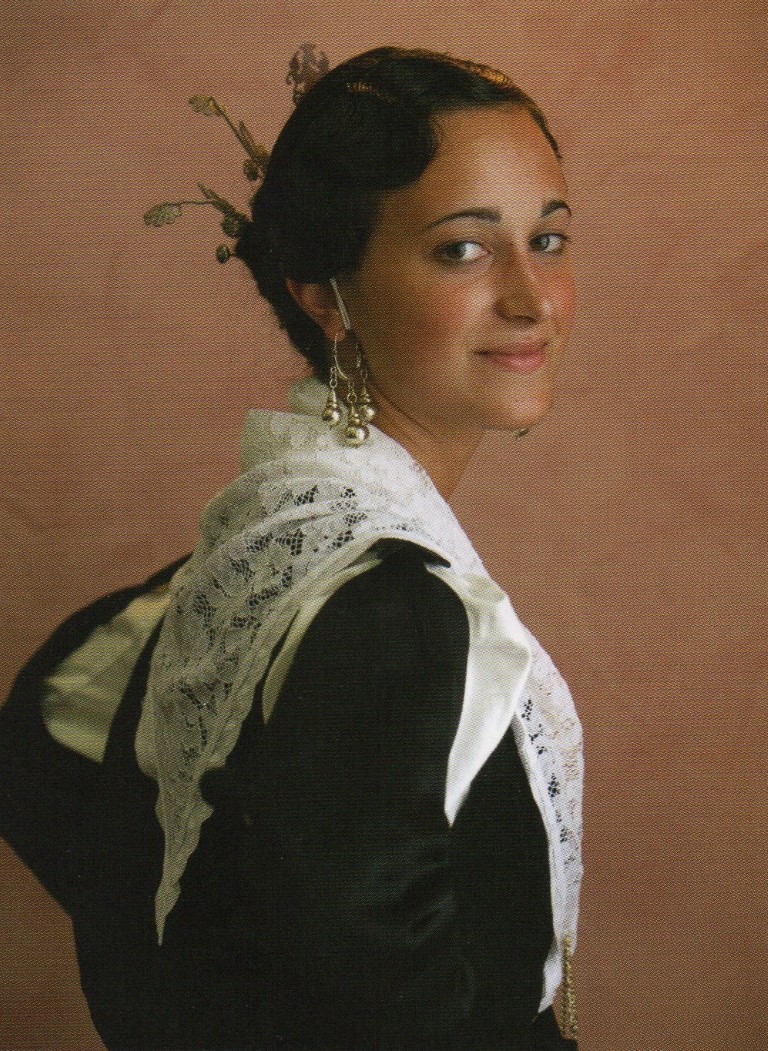
vadbenoj_nošnji_Danilo Dragosavac (Medium)
Galižana’s Men’s Costume
Men’s costume was much less elaborate than female. For holidays, men wore a white flax or linen shirt with a high collar, pleated on the chest (camisa). Above it, they wore a vest made of black cloth or fabric with crossed pleats, double-breasted and folded on the chest (camisolin). Black trousers (braghe de gorgan) made of wool felt were ankle length. They also wore a short black buttonless jacket. White socks (calse) were knee high, and calfskin shoes were natural colour and tied with laces. They wore hats made of black fabric. Many young men wore a little gold hoop earring in their right ear.
PEROJ’S COSTUME – Precious Embroidery of Orthodox Heritage
On the southwest coast of southern Istria, surrounded by Mediterranean vegetation, lies Peroj, called Peroja by its autochthonous inhabitants. Peroj is a prehistoric settlement known as a summer resort as early as the Roman era, with an utterly unique historical trajectory in Istria. Thirteen Greek-Orthodox families, ancestors of today’s residents, moved from Montenegro to Peroj in the seventeenth century, then under the protection of Venice to fight against their common enemy, the Ottomans. As a token of gratitude, they were given the little Istrian village situated only one kilometre from the shore, commanding a beautiful view of the Brijuni islands. After 130 years of waiting, having to celebrate liturgy at the Orthodox Church of St Nicholas in Pula, in 1788, they finally witnessed the building of their own impressive church dedicated to Saint Spyridon the miracle-maker, after which they got a belltower with a dome and the Orthodox cemetery. Preservation of religious tradition accompanied all aspects of daily life of the residents of Peroj, first and foremost shepherds and herdsmen who would only later start growing vine and olive trees.
Living on their little Orthodox island in the sea of Catholic religious buildings and surrounded on all sides by the Istro-Romanian population, they have largely preserved the linguistic and other ethnic features of their old homeland. In particular, they preserved their lively women’s costume, one of the most interesting phenomena of our ethnographic findings owing to its rich and harmonious variegated embroidery, stated Dr Jelka Ribarić Radauš, author of the book “Female costume in Istria”. Dr Ribarić Radauš puts the value of embroidery of Peroj’s female costume “on a level with the noblest embroideries of Konavle and the surroundings of Zadar”.
Peroj’s Women’s Costume
Peroj’s festive costume consisted of a shirt richly embroidered with silk on the chest and sleeves and equipped with numerous and colourful tassels. The shirt was covered with green wool clothes called raša under which you could see only sleeves and the richly embroidered chest of the shirt. All the shirt embroidery was made using domestic silk since the residents of Peroj bred silkworms. The shirt was girded with a red belt (kanica) and an apron called traveša. On their head, women from Peroj wore a tied embroidered kerchief called faculet also decorated with silk tassels falling on the forehead. Footwear included the socks called nazubice, and sometimes they wore openki š kljunom or crevlje.

Peroj folk costume (Photo credit: Danilo Dragosavac)
Women from Peroj, much like women from Vodnjan and Galižana, liked to wear a lot of jewellery, and the most important piece of jewellery was a brass or silver-plated round toka worn on the chest, i.e., a ring with a little cross decorated with glass beads tied to the upper garments with a red ribbon. There were also buckles called maite and čamprage and headpiece ornaments and earrings.
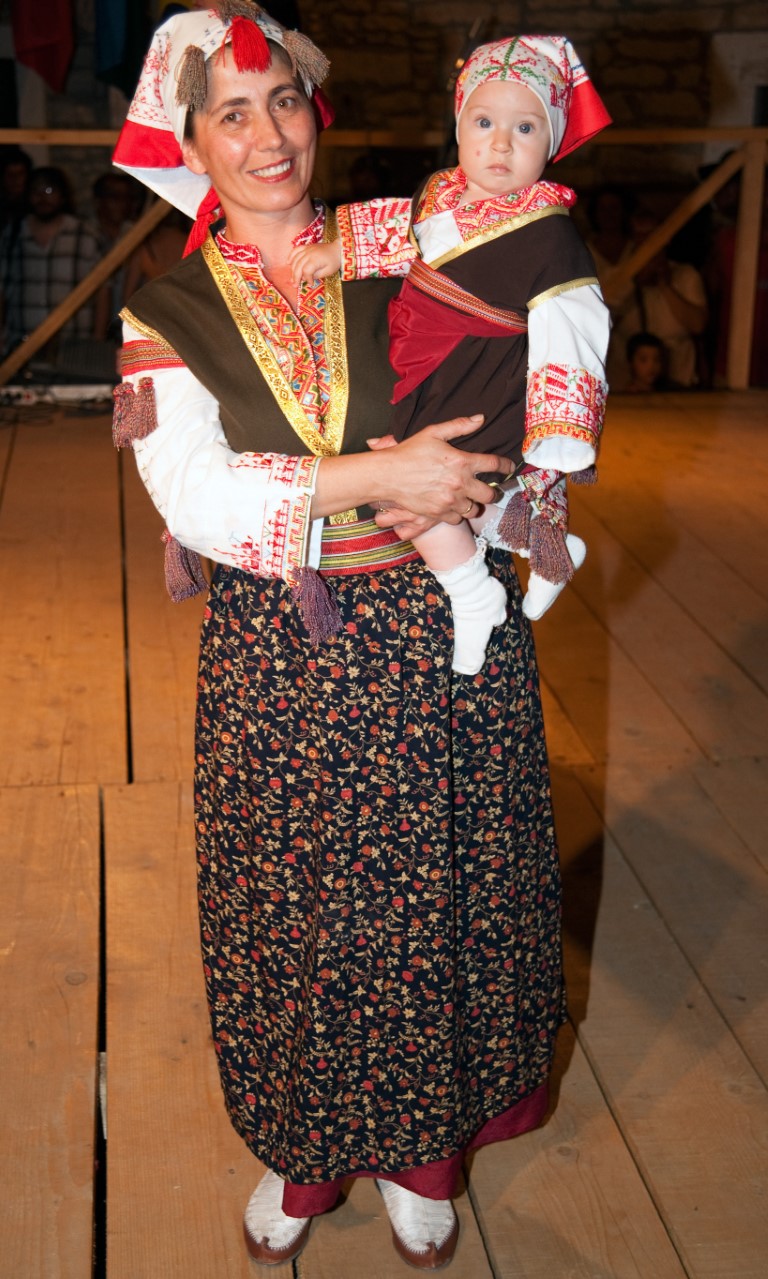
Peroj folk costume (Photo credit: Danilo Dragosavac)
As for hair, two braids were wrapped around the head and could not be seen under the kerchief. At weddings, the Peroj bride would wrap her braids with the red ribbon called cantalina to make the hair look as rich as possible and the kerchief thus looked more festive.
Peroj’s Men’s Costume
Unfortunately, Peroj’s men’s costume has not been preserved, although people remember that the ancient male attire included pas na struke consisting of red wool cords and was decorated with domestic silk, a piece which is now kept at the Ethnographic Museum in Zagreb. In time, people from Peroj completely accepted the attire significant for other uskoks in Istria, i.e., long trousers made of white fabric called benevreke, the topcoat with sleeves or koret and the vest called koržet, both of these garments made of domestic cloth.
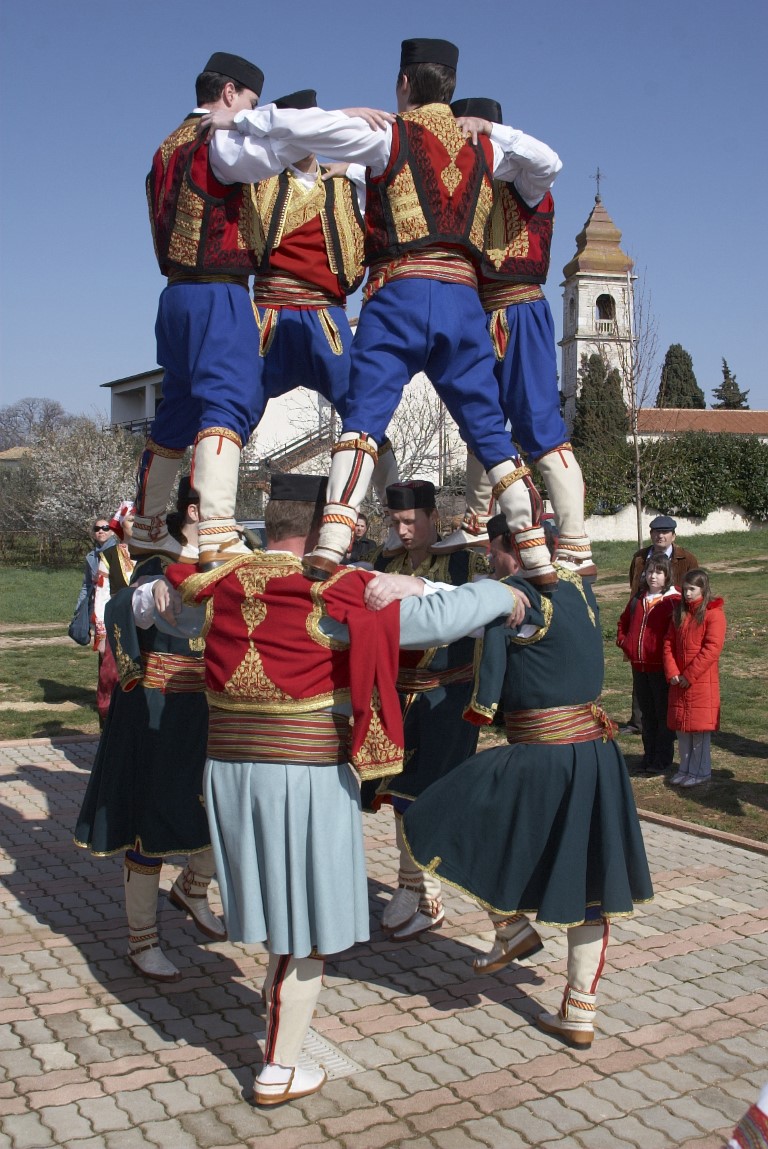
Peroj (Photo credit: Danilo Dragosavac)
ISTRIAN COSTUME – Simplicity Decorated With Jewellery
Let us also mention the traditional costume that was not that frequent in the Vodnjan area, although it was characteristic of this area as it was worn by south Istrian Croats who were not autochthonous inhabitants of Vodnjan, Galižana and Peroj.
The female attire consisted of a linen shirt on top of which was a long-sleeved cloth or modrna girded with a wool belt or kanica. In the winter, on top of the modrna came a long cloth čerma and a scarf called krpet. The faco na kite worn on the head was later replaced by facol, with a traverša tied around the waist. Women braided their hair, and the braids were interwoven with white and red kordele. Well-off women wore jewellery typical of all Istria. Kolare and kovane: pašete around the neck, stars and crosses or križe on the chest, brooches-puntapete on shirts and rančine in the ears.
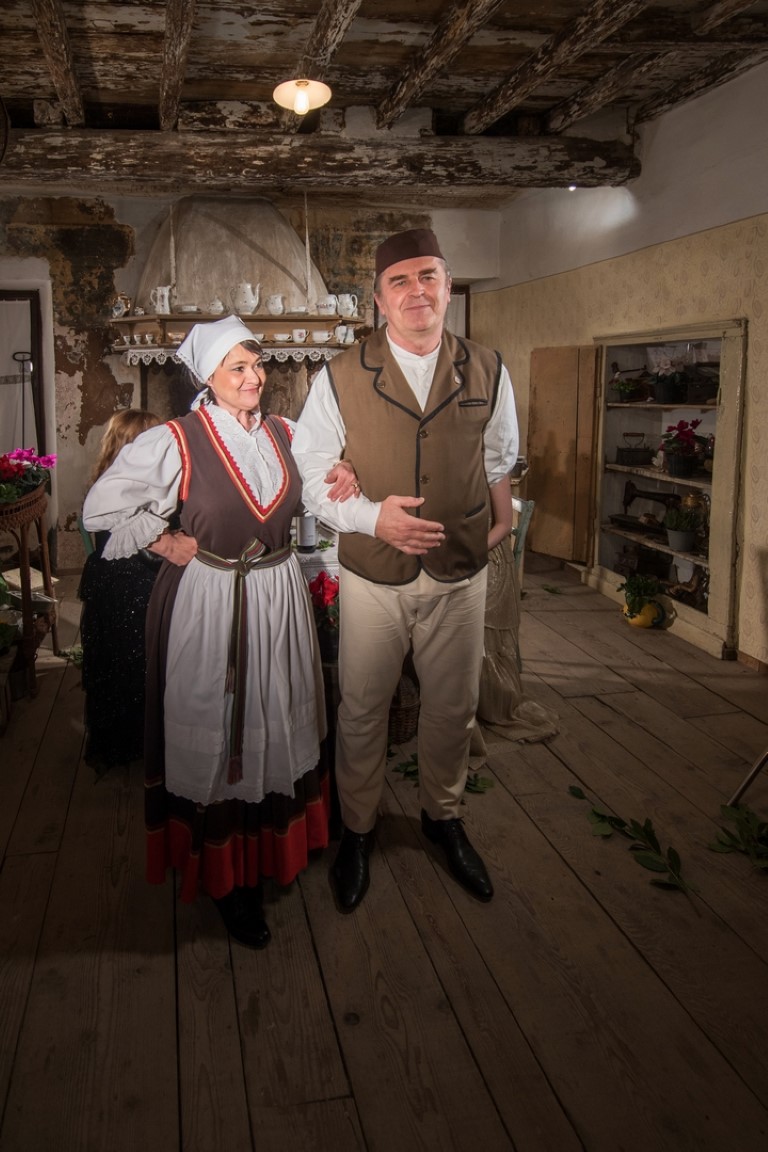
Istarian folk costume (Photo credit: Danilo Dragosavac photography)
Men wore trousers made of white cloth, a dark sleeveless cloth jacket worn on one arm only and a cap. Interestingly, men wore earrings in their right ear, and the earring size depended the wealth of the best man who bought it. The clothes of shepherds from the environs of Vodnjan consisted of a shirt, supposed to make them stronger, whereas as adults, they tended cattle wearing trousers, shirts, a hat, leather shoes called opanci and a jacket.
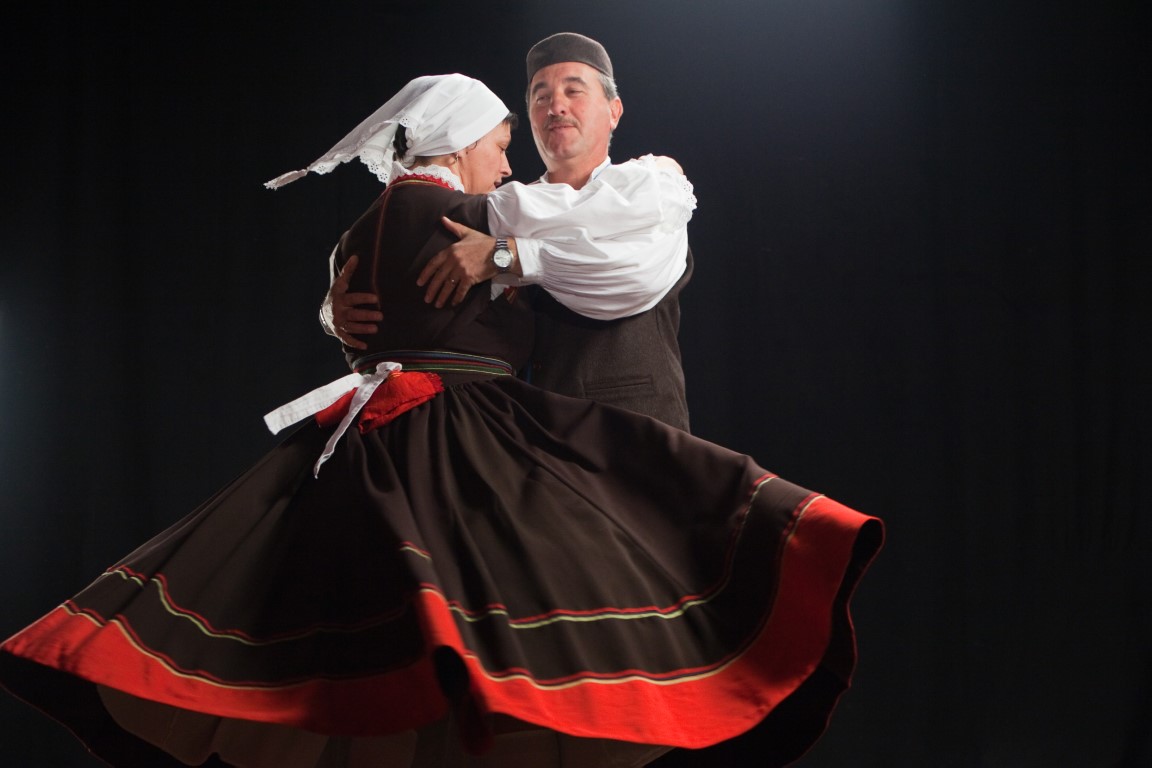
Istarian folk costume (Photo credit: Danilo Dragosavac photography)
All costumes are priceless heritage whose every detail reveals the past life of the inhabitants of Vodnjan, Galižana and Peroj. Thanks to valuable sources such as the book by Dr. Jelka Ribarić Radauš “Female costume in Istria” and to the group of authors of the monograph “Vodnjan-Dignano – Town Stories” (Anita Forlani, Luana Moscarda, Matija Drandić, Danilo Ljubotina), we have taken a look into the mirror of the past hoping that the beautiful costumes of the Vodnjan area will encourage you to visit this part of Istria.
This post was originally published on this site be sure to check out more of their content.





